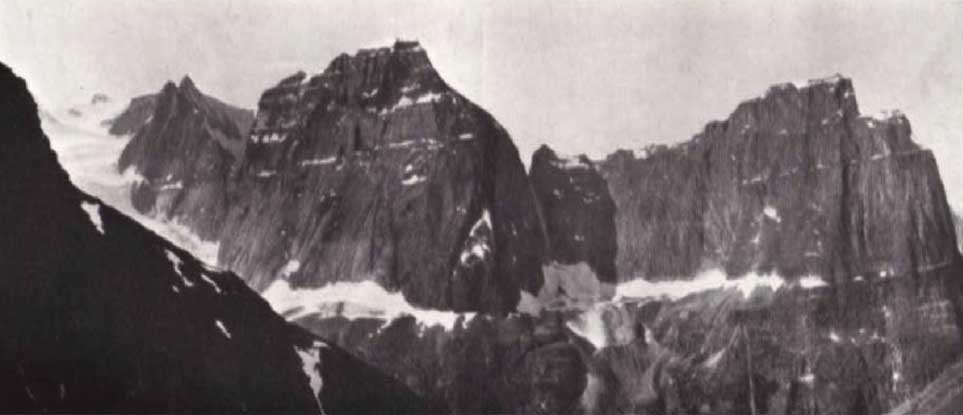Flows W into North Thompson River W of junction with Albreda River
52.35 N 119.1667 W — Map 83D/6 — Google — GeoHack
Official in BC – Topo map from Canadian Geographical Names
Possibly named by the Alberta-British Columbia Boundary Commission in 1923, although the name doesn’t appear on Boundary Commission Sheet 38 (surveyed in 1924).

Grouse – Ptarmigan, Mount Robson
William James Topley, 1914
Library and Archives Canada
The name was changed to “Titkana Peak” to avoid duplication.
Origin of the name unknown.
“Premier Group” of mountains, later “Premier Range,” was proclaimed in 1927 to commemorate prime ministers of Canada and Great Britain and premiers of British Columbia. The occasion of the proclimation was the Diamond Jubilee of Confederation. Canada celebrated 60 years of Dominion in 1927.
The range was in initially designated “Premier Group” by Order in Council, as arraigned by the government of British Columbia and the Geographic Board of Canada. The form of the name was changed to “Premier Range” in 1962, and it was declared that those peaks over 10,000 feet would be named after deceased former prime ministers of Canada.
Most of the mountains already had unofficial names bestowed by early explorers, recognizing people, features, and events. Those names, many of them featured on maps published in the Canadian Alpine Journal, were replaced by the names of mostly distant politicians. John Oliver came close when he visited McBride in 1925, where his daughter taught school and was principal. Laurier visited Kamloops in 1910, when, learning that he was in favour of larger reserves and recognition of aboriginal title, the chiefs of the Shuswap, Okanagan, and Thompson tribes presented him with a petition condemning BC land policies and game laws and rejecting BC’s takeover of their lands.
Several peaks had unofficial names that were superseded:
Laurier Glacier — not Hostility Glacier
Mount Arthur Meighen — not Mount Carpé
Mount Richard Bennett — not Mount Goddell
Mount Mackenzie King — not Hostility Mountain
Tête Glacier — not Holway Glacier
Penny Mountain — not Holways Peak
As well, the following names were no longer to be used:
Chamberlin, Mount
Withers, Mount
Crescent Mountain
Mount David
Forks Peak
Pyramid Peak
Mount Zillmer
Incisor Peak
Mount Zillmer, however, remains in official use.
There are 16 peaks above 9800 feet still unnamed in the Premier Range, of which 7 peaks exceed 10,000 feet. Other than the 1927 decision to name the highest peak (11,750 feet) after Sir Wilfrid Laurier, the relative elevation and location have not been considered when designating the peaks in this range.

Mt. Casemate (left) and Mt. Postern (right) looking across the Geikie Valley from Drawbridge
Cyril G. Wates, 1926
Canadian Alpine Journal 1927
Charles Poser was resident engineer of construction on the Grand Trunk Pacific Railway between McBride and Prince George during 1912 and 1913.
A portcullis is a strong frame or grating, formed of vertical and horizontal bars of wood or iron, suspended by chains, and made to slide up and down in vertical grooves at the sides of the gateway of a fortress, so as to be capable of being quickly let down as a defence against assault. The feature was named by the survetors of the Alberta-British Columbia Boundary Commission in 1921.
A portal is a gateway or entrance. The lake sits at the portal to Yellowhead Pass. The name does not appear in any historical documents that I am aware of.